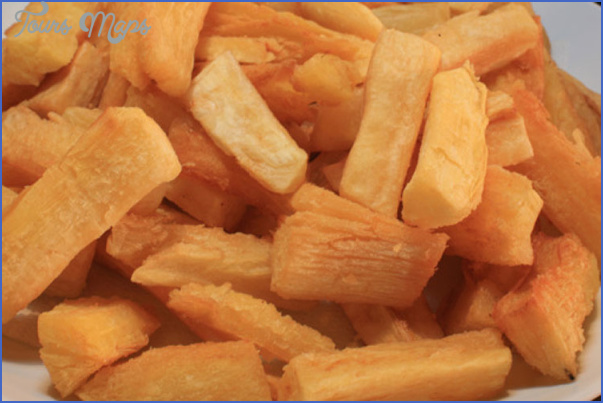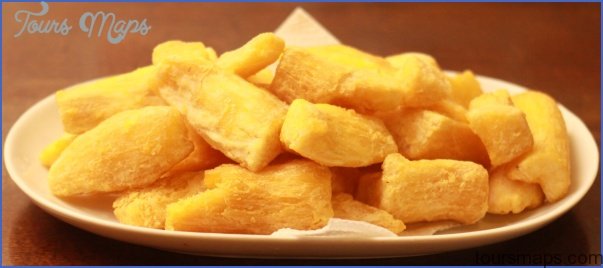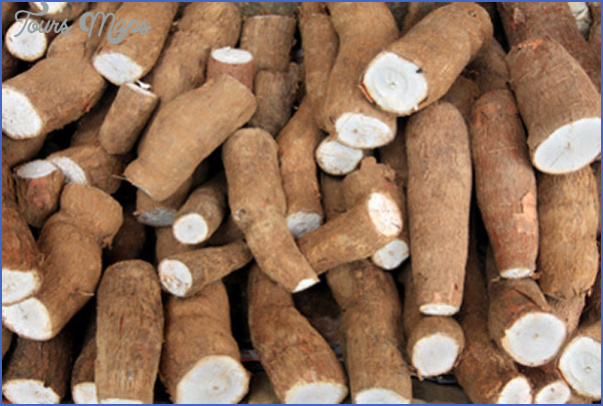Mandioca (cassava or yucca root) is a staple food of Paraguay, so much so that there is a popular saying: Es mas paraguayo que la mandioca (He’s more Paraguayan than mandioca).The tuber has an outer bark-like layer that is brown and papery. This is removed along with the first inner layer of the root. The remaining bright white to pale yellow interior is then boiled until soft. Mandioca is eaten plain alongside most meals. Mandioca is very filling as well as cheap and easy to grow. For the rural poor, it is a significant source of carbohydrates, and a small plot of mandioca can act as a nutritional safety net. One of the most popular mandioca based dishes is mandi ‘o chyryry, a concoction of fried mandioca, eggs, and onions.
Mandioca starch (tapioca), known as almidon, is a key ingredient in several traditional dishes. In the countryside, many families still make their own starch, an arduous and lengthy process involving grinding up the mandioca, allowing the starch to separate from the tuber’s liquid, and spreading it out to dry in the sun. Almidon is the primary ingredient for mbeju, a traditional winter dish. Starch, cheese, lard, and eggs are combined until they form a crumbly dough, which is then pressed into an iron skillet and placed over the fire. Everything melds together to form a gooey pancake. Once is it cooled, you can pull and rip off pieces.
There Is a Day for Every Food
Certain foods are traditionally consumed on specific days. Locro, a hearty stew made with hominy and beef, is prepared on Mondays in order to start the week strong. Thursdays and Sundays call for special dishes such as tallarin. Following in the footsteps of Argentina, the 29th of every month is noqui (gnocchi or potato dumpling) day. Knocking back a shot of carrulm (made with cana alcohol, rue herb, and lemon) on August 1st and eating a bowl of jopara (a bean and beef soup) on October 1st are said to ward off bad luck.
Meats
Paraguayans are quite carnivorous – for most, a meal based around meat is preferable to one based around vegetables. Bifes (steaks) and lomitos (thin-cut steaks) are popular as are milanesas (breaded fried steaks). These are sometimes accompanied by fried eggs and onions (bife koygua or bife al caballo) or topped with red sauce, ham, and cheese (a la napolitana). As many rural Paraguayans live on a limited diet, there are a variety of dishes designed to use all parts of the animal. Guisos (stews), estofados (ragu type sauces), and caldos (soups) abound. Larger portions of meat are served up during asados (barbeques). Generally all asados consist of large hunks of beef, chorizo (sausage), morcilla (blood sausage), and of course, mandioca. Sides, such as sopa paraguaya and rice or potato salads, are also common. In the Misiones department, asado is prepared a la estaca – cuts of meat are skewered onto large stakes placed around a large patch of burning coals.
Sidebar: Paraguayans like their meat very well done. If you prefer your meat rare or medium rare, simply tell the asadero (master of the grill) you like your meat jugoso (juicy), and have him take a cut of meat off the grill early for you.
World Records
In 2011, Paraguay became the Guinness Book of World Records holder for the world’s longest hotdog at 203 meters. Paraguay also holds the record for the largest open-air barbeque, set in 2008 when over 40,000 people gathered to consume 26,715 kilos of meat.
Street Meats
It is not surprising that the majority of street food options (aside from chipa) revolve around meat. Every night in every town, street stands or kiosks feature the following:
Lomitos Cooked to order, lomitos are thin cuts of meat, grilled up, slapped between two pieces of bread, and topped with a fried egg, ham, cheese, lettuce, and tomato.
Lomito Arabe Paraguay’s small Middle Eastern community has made a widespread contribution to the country’s cuisine in the form of the shwarma, known here as a lomito arabe. The most authentic lomito arabe stands serve shwarma in pita bread with optional hummus, falafel, and babaganoush. Paraguayan twists include copious amounts of mayonnaise.
Asadito Asadito are meat kabobs – grilled bite-sized chunks of meat on a stick. Asaditos are usually accompanied with a side of mandioca. No frills, but it gets the job done.
Empanadas These ubiquitous mini calzones are usually deep fried and filled with ground beef (carne), chicken (pollo), or ham and cheese (jamon y queso). Empanadas de mandioca have a thick dough made with mandioca starch. There are vegetarian options such as corn (choclo) or onion (cebolla), though these are rare outside of urban areas.
Mandioca Photo Gallery
Maybe You Like Them Too
- The Best Cities To Visit in The World
- World’s 10 Best Places To Visit
- Coolest Countries in the World to Visit
- Travel to Santorini, Greece
- Map of Barbados – Holiday in Barbados








